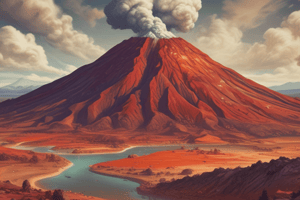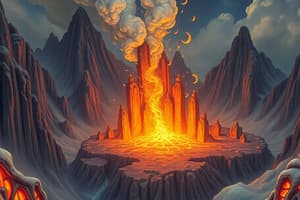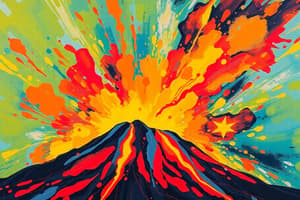Podcast
Questions and Answers
What is the characteristic of lahars when they are most dangerous?
What is the characteristic of lahars when they are most dangerous?
- When they are dry and powdery
- When they are wet and fluid (correct)
- When they are cold and solid
- When they are hot and fluid
What is the primary reason why ash fall poses a great danger to airplanes?
What is the primary reason why ash fall poses a great danger to airplanes?
- Ashes can cause visibility problems
- Ashes can block sunrays
- Ashes can interfere with the plane's engines (correct)
- Ashes can cause climate cooling
What is the result of excessive ash fall on crops?
What is the result of excessive ash fall on crops?
- Crops grow faster
- Crops become more fertile
- Crops are destroyed (correct)
- Crops are unaffected
What is the term used to describe the collective materials that come out of the volcano's mouth during an explosive eruption?
What is the term used to describe the collective materials that come out of the volcano's mouth during an explosive eruption?
What is the effect of ash fall on the environment?
What is the effect of ash fall on the environment?
What is the composition of ash fall?
What is the composition of ash fall?
What is the term for molten materials that come out of the surface during a volcanic eruption?
What is the term for molten materials that come out of the surface during a volcanic eruption?
How are active volcanoes classified by PHIVOLCS?
How are active volcanoes classified by PHIVOLCS?
What is the term for a type of mudflow or debris flow that forms when pyroclastic materials mix with rainwater or water from a volcano's crater lake?
What is the term for a type of mudflow or debris flow that forms when pyroclastic materials mix with rainwater or water from a volcano's crater lake?
What is the term for various forms of matter ejected by a volcano during its eruption?
What is the term for various forms of matter ejected by a volcano during its eruption?
What is the term for a vent on the earth's crust where magma moves up from the depths of the earth to its surface and into the atmosphere?
What is the term for a vent on the earth's crust where magma moves up from the depths of the earth to its surface and into the atmosphere?
What type of volcano has a physical form that is being changed by agents of weathering and erosion?
What type of volcano has a physical form that is being changed by agents of weathering and erosion?
What is radon?
What is radon?
What occurs prior to an earthquake event?
What occurs prior to an earthquake event?
What is the term used to describe a series of mild local movements that occur frequently at short periods of time at almost similar depths?
What is the term used to describe a series of mild local movements that occur frequently at short periods of time at almost similar depths?
What is the main difference between landslides and slope failure?
What is the main difference between landslides and slope failure?
What is an aquifer?
What is an aquifer?
What is the purpose of studying earthquake trends?
What is the purpose of studying earthquake trends?
What is the primary cause of seismic waves during an earthquake?
What is the primary cause of seismic waves during an earthquake?
What is the term used to describe the breaking or fracture of the earth's surface or rocks?
What is the term used to describe the breaking or fracture of the earth's surface or rocks?
What is the result of the increase in water pressure in the soil during an earthquake?
What is the result of the increase in water pressure in the soil during an earthquake?
What is the term used to describe the process of the ground sinking or developing a depression due to liquefaction?
What is the term used to describe the process of the ground sinking or developing a depression due to liquefaction?
What is one of the effects of liquefaction?
What is one of the effects of liquefaction?
What can be formed as a result of the process of subsidence?
What can be formed as a result of the process of subsidence?
What is the maximum speed that pyroclastic flows can travel?
What is the maximum speed that pyroclastic flows can travel?
What is the temperature range of rocks and gas inside pyroclastic flows?
What is the temperature range of rocks and gas inside pyroclastic flows?
What is the primary factor that affects the direction of pyroclastic flows?
What is the primary factor that affects the direction of pyroclastic flows?
What is the term used to describe the turbulent rush of pyroclastic materials above the pyroclastic flow?
What is the term used to describe the turbulent rush of pyroclastic materials above the pyroclastic flow?
What is the minimum size of rock fragments that are classified as blocks or bombs?
What is the minimum size of rock fragments that are classified as blocks or bombs?
What was the approximate number of inhabitants killed when Mt. Pelee erupted on May 8, 1902?
What was the approximate number of inhabitants killed when Mt. Pelee erupted on May 8, 1902?
Flashcards
Lahars: Most Dangerous
Lahars: Most Dangerous
Lahars are most dangerous when they are wet and fluid, allowing them to travel further and spread more destructively.
Ash Fall & Airplanes
Ash Fall & Airplanes
Ash fall poses danger to airplanes because volcanic ash can clog their engines, causing them to malfunction.
Ash Fall & Crops
Ash Fall & Crops
Excessive ash fall destroys crops, making them inedible and unproductive.
Pyroclastic Flow
Pyroclastic Flow
Signup and view all the flashcards
Ash Fall Environmental Effects
Ash Fall Environmental Effects
Signup and view all the flashcards
Ash Fall Composition
Ash Fall Composition
Signup and view all the flashcards
Lava
Lava
Signup and view all the flashcards
Active Volcano Classification
Active Volcano Classification
Signup and view all the flashcards
Lahar
Lahar
Signup and view all the flashcards
Pyroclastic Materials
Pyroclastic Materials
Signup and view all the flashcards
Volcano
Volcano
Signup and view all the flashcards
Inactive Volcano
Inactive Volcano
Signup and view all the flashcards
Radon
Radon
Signup and view all the flashcards
Earthquake Radon
Earthquake Radon
Signup and view all the flashcards
Earthquake Swarms
Earthquake Swarms
Signup and view all the flashcards
Landslide vs. Slope Failure
Landslide vs. Slope Failure
Signup and view all the flashcards
Aquifer
Aquifer
Signup and view all the flashcards
Earthquake Trend Study
Earthquake Trend Study
Signup and view all the flashcards
Seismic Waves Cause
Seismic Waves Cause
Signup and view all the flashcards
Ground Rupture
Ground Rupture
Signup and view all the flashcards
Water Pressure & Earthquake
Water Pressure & Earthquake
Signup and view all the flashcards
Subsidence
Subsidence
Signup and view all the flashcards
Liquefaction Effect
Liquefaction Effect
Signup and view all the flashcards
Subsidence Result
Subsidence Result
Signup and view all the flashcards
Pyroclastic Flow Speed
Pyroclastic Flow Speed
Signup and view all the flashcards
Pyroclastic Flow Temperature
Pyroclastic Flow Temperature
Signup and view all the flashcards
Pyroclastic Flow Direction
Pyroclastic Flow Direction
Signup and view all the flashcards
Pyroclastic Surge
Pyroclastic Surge
Signup and view all the flashcards
Large Pyroclastic Fragment Size
Large Pyroclastic Fragment Size
Signup and view all the flashcards
Mt. Pelee Death Toll
Mt. Pelee Death Toll
Signup and view all the flashcards




